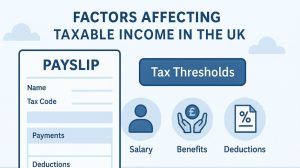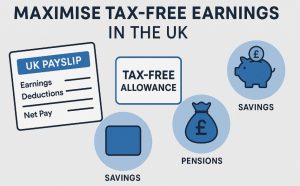Table of Contents
ToggleAs of the 2025/26 tax year in the UK, individuals can earn up to £1,048 per month before they start paying income tax. This threshold is based on the annual Personal Allowance, which is the amount of income you’re allowed to receive before HMRC begins taxing you.
But monthly earnings can be complex. National Insurance Contributions (NICs), employment status, tax codes, and additional allowances can all influence how much you actually take home each month.
Whether you’re a full-time employee, freelancer, student or part-time worker, understanding how tax thresholds work on a monthly basis helps you make informed financial decisions and avoid unpleasant surprises.
Let’s explore exactly how much you can earn before paying tax per month in 2025 and how to legally maximise your tax-free income.
What Is the Personal Allowance in the UK for 2025/26?

What Is the Personal Tax-Free Income Threshold in 2025?
The Personal Allowance is the income you’re allowed to earn before any income tax is charged. For the 2025/26 tax year, this amount remains frozen at £12,570 per year.
This threshold has been unchanged since April 2021, as part of the UK government’s multi-year freeze on income tax thresholds. The freeze is set to continue until at least April 2028.
This allowance applies to most taxpayers, including employees, pensioners, and self-employed individuals.
However, if your total income exceeds £100,000 a year, your allowance begins to reduce by £1 for every £2 you earn over the £100,000 limit, meaning you completely lose your tax-free allowance at £125,140 annual income.
How Much Does the Monthly Personal Allowance Equal in 2025?
To find out how much you can earn tax-free per month, simply divide the annual Personal Allowance by 12:
- £12,570 / 12 = £1,047.50 (rounded to £1,048)
So, if you’re earning £1,048 or less per month, you won’t pay any income tax. This applies across PAYE (Pay As You Earn) and self-employment if your total income for the year stays under the threshold.
Who Is Eligible for the Full Personal Allowance This Year?
Eligibility is automatic for most people who:
- Live in the UK
- Earn less than £100,000 annually
- Have a standard tax code (usually 1257L in 2025)
Your allowance can be higher if you qualify for additional reliefs or allowances, such as Marriage Allowance or Blind Person’s Allowance.
What Are the Current Income Tax Thresholds and Bands in 2025?
What Are the Basic, Higher, and Additional Tax Bands in 2025?
Income tax in the UK is progressive, meaning higher earnings attract higher rates. In 2025, the tax bands are structured as follows:
| Tax Band | Annual Income | Monthly Equivalent | Tax Rate |
| Personal Allowance | £0 – £12,570 | £0 – £1,048 | 0% |
| Basic Rate | £12,571 – £50,270 | £1,049 – £4,189 | 20% |
| Higher Rate | £50,271 – £125,140 | £4,190 – £10,428 | 40% |
| Additional Rate | Over £125,140 | £10,429+ | 45% |
If you earn £1,200 a month, only the income above £1,048 (i.e., £152) is taxed at 20%, which equates to £30.40 in tax.
How Does Your Tax Code Influence Your Monthly Take-Home Pay?
Your tax code tells your employer how much tax-free income you’re entitled to. The standard code in 2025 is 1257L, which indicates you are receiving the full personal allowance.
If you have a second job, receive certain benefits, or owe tax from a previous year, HMRC may change your tax code, resulting in less monthly tax-free income.
It’s crucial to regularly check your tax code via your HMRC online personal account to ensure accuracy and avoid under- or overpaying tax.
What Should You Know About National Insurance Contributions in 2025?

What Are the NIC Thresholds for Employees and Self-Employed?
NICs are separate from income tax and are payable once your earnings exceed certain limits. For 2025/26:
- Employees begin paying NICs once they earn over £1,048 per month
- Self-employed pay Class 4 NICs once their profits exceed £12,570 per year
As of 2024, Class 2 NICs for self-employed individuals have been abolished, simplifying the tax system for sole traders.
How Much Can You Earn Monthly Without Paying NIC?
The monthly Primary Threshold for employees is £1,048. Below this, no NIC is due. Above this, employees pay:
- 8% on earnings between £1,048 and £4,189/month
- 2% on earnings above £4,189/month
Self-employed individuals pay 8% on annual profits between £12,570 and £50,270, and 2% thereafter. NICs are assessed annually via Self Assessment but can be broken down into monthly equivalents to help with budgeting.
How Are NIC and Income Tax Calculated Together?
For employees, NIC and income tax are both deducted at source via PAYE. For self-employed people, both are paid via the Self Assessment system, typically in two payments on 31st January and 31st July.
How Does Tax-Free Income Differ Between Employees and Self-Employed in 2025?
How Does PAYE Affect Income Tax Deductions Monthly?
Employees under the PAYE system have tax and NIC deducted directly from their payslips each month. The system uses your tax code to apply your monthly personal allowance automatically. If you stay under the monthly threshold of £1,048, you won’t see any deductions for tax or NIC.
What Are the 2025 Tax-Free Limits for Self-Employed Workers?
Self-employed individuals can earn up to £12,570 annually (about £1,048 per month) in profits before paying income tax or NICs. Profits are calculated after deducting allowable expenses from total income, so self-employed people often have more flexibility in managing their tax position.
What Are the Key Differences in Tax for Employed vs Self-Employed?
Employees are taxed on gross salary, while self-employed workers are taxed on net profits. Employees benefit from automatic deductions, but self-employed individuals can claim business-related expenses such as:
- Office supplies
- Marketing costs
- Software subscriptions
This can reduce your taxable profit, effectively increasing your tax-free take-home.
What Other Factors Can Affect How Much You Earn Before Paying Tax?

How Do Allowances Like Marriage or Blind Person’s Affect Tax-Free Earnings?
Additional allowances can extend your tax-free monthly income:
- Marriage Allowance allows a non-taxpaying spouse to transfer £1,260 of their unused allowance to their partner, increasing the recipient’s allowance to £13,830 annually.
- Blind Person’s Allowance provides an extra £3,070 tax-free, taking your total allowance to £15,640 if eligible.
This equates to a potential monthly tax-free income of up to £1,303 for eligible individuals.
How Do Savings, Dividends, and Investments Impact Your Tax Threshold?
Income from savings, dividends, and investments can push you into higher tax bands:
- Basic rate taxpayers get a £1,000 savings allowance
- Dividend income is tax-free up to £500 in 2025
Any investment income exceeding these limits adds to your total taxable income, which may reduce your personal allowance if your earnings exceed £100,000.
How Does HMRC Adjust Your Tax Code for Monthly Income?
HMRC may modify your tax code to collect underpaid taxes, benefits in kind, or other adjustments. For example, if you receive a company car or private healthcare through work, your tax code will be lowered to account for the value of these benefits.
What Are Common Income Scenarios and Their Tax Implications?
How Much Can You Earn Part-Time Without Paying Tax?
Many part-time workers earn under £1,048 per month and therefore avoid income tax and NIC. This makes part-time work ideal for:
- Students
- Stay-at-home parents
- Semi-retired individuals
If your employer deducts tax by mistake, you can request a refund at the end of the tax year.
What Happens If You Have Multiple Income Sources?
When you have more than one job or income stream, each source may be taxed differently. HMRC typically applies your full personal allowance to your main job and taxes secondary income without any allowance.
To avoid over-taxation:
- Contact HMRC to reallocate your allowance
- Complete a Self-Assessment return if needed
How Do Student Jobs and Pensions Affect Monthly Tax-Free Limits?
Students are taxed the same as any other employee, but many earn under the allowance limit. If you’re on a zero-hour contract or summer placement, and your annual income is under £12,570, you can claim a refund later.
Pensions count as taxable income. If you’re receiving the state pension plus private income, both will be counted toward your allowance, potentially reducing your tax-free threshold.
How Can You Maximise Your Tax-Free Earnings Legally?

What Are the Legal Ways to Reduce Taxable Income in 2025?
There are several ways to reduce your tax burden without breaking the law:
- Claim all allowable expenses if self-employed
- Contribute more to pensions
- Use tax-efficient accounts like ISAs
- Transfer part of your allowance to a spouse
How Do Salary Sacrifice Schemes Help with Tax Efficiency?
Salary sacrifice involves giving up part of your salary in exchange for non-cash benefits such as:
- Pension contributions
- Cycle-to-work schemes
- Childcare benefits
These reduce your gross salary, meaning you pay less income tax and NICs.
Why Is It Important to Keep Accurate Financial Records?
Keeping detailed records of your income, expenses, and tax code changes helps you:
- Stay compliant with HMRC
- Claim allowable deductions
- Avoid fines or missed refunds
How Much Can You Earn Per Month Without Paying Tax in 2025?

In the 2025/26 tax year, the majority of UK taxpayers can earn up to £1,048 per month before paying any income tax or National Insurance. However, this amount can increase with additional allowances or decrease if your tax code is adjusted due to benefits or unpaid tax.
Understanding the tax-free thresholds helps you budget more accurately, especially if you have multiple sources of income or are self-employed.
What Are the Monthly Tax-Free Allowances and Tax Bands in 2025?
| Category | Monthly Income Range | Tax Rate | Notes |
| Personal Allowance | £0 – £1,048 | 0% | Standard threshold |
| Basic Rate | £1,049 – £4,189 | 20% | Applies after allowance |
| Higher Rate | £4,190 – £10,428 | 40% | Mid-high earners |
| Additional Rate | £10,429+ | 45% | High earners |
| NICs Start | £1,048+ | 8% (Employees) | Monthly NIC threshold |
Conclusion: What Is the Maximum Monthly Income You Can Earn Tax-Free in the UK?
The monthly tax-free threshold of £1,048 applies to most UK taxpayers in 2025/26. Earning below this amount keeps you free from both income tax and NICs. However, allowances, benefits, and employment status can shift your actual tax position.
Understanding the income thresholds, keeping your tax code accurate, and applying for relevant allowances can help you maximise your tax-free earnings and keep more of what you earn.
Frequently Asked Questions
How does the trading allowance affect my tax-free income?
The trading allowance allows self-employed individuals to earn £1,000 annually without declaring or paying tax on it. It’s useful for side hustles and part-time gigs.
What is the High Income Child Benefit Charge?
If you or your partner earns over £60,000, you may need to repay some or all of your child benefit via this charge, even if your monthly income is tax-free.
Can I get a refund if I’m taxed below the allowance?
Yes. If your total annual income is below £12,570 but tax was deducted (e.g., short-term jobs), you can claim a refund from HMRC after the tax year ends.
Are pensions always taxable?
Yes. State pensions, private pensions, and workplace pensions count toward your taxable income and are subject to the same thresholds.
Can benefits in kind reduce my personal allowance?
Yes, benefits like company cars or health insurance are valued and deducted from your personal allowance through tax code adjustments.
Is Universal Credit taxable?
No, Universal Credit is not taxable. However, it’s means-tested and may be affected by your other earnings.
How often should I check my tax code?
You should check your HMRC online account at least once per tax year or whenever you change jobs, income sources, or personal circumstances.




